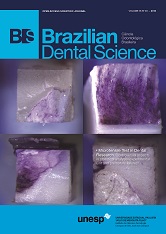Antifungal effect of plant extracts on Candida albicans biofilm on acrylic resin
DOI:
https://doi.org/10.14295/bds.2013.v16i3.909Abstract
Objective: Evaluating the antifungal potential of
Equisetum arvense L. (horsetail), Glycyrrhiza glabra
L. (licorice), Punica granatum L. (pomegranate) and
Stryphnodendron barbatimam Mart. (barbatimão)
extracts, after Candida albicans biofilm formation
on acrylic resin. Material and methods: C. albicans
standard strain was cultured on Sabourauddextrose
agar for 24 h at 37 °C. After standardized
in a spectrophotometer, 100 ?L of the inoculum
(106 cells/mL) and a sterile acrylic resin disc
were maintained in Brain Heart Infusion broth
supplemented with sucrose (5%), for 5 days at 37
ºC. The samples of the treated groups (n = 10) were
separately exposed to a concentration of 50 mg/mL
of each extract for 5 minutes or to nystatin (48.83
IU/mL). For the untreated group (control, n = 10),
it was used sterile saline (0.9% NaCl). Biofilms
were disaggregated from the acrylic resin discs by
an ultrasonic homogenizer for 30 s. After decimal
dilutions, sowings in Sabouraud-dextrose plates
were made with incubation for 48 h at 37°C. Later,
CFU/mL was verified and the values were converted
to log10 and they had their statistical analysis done
(ANOVA and Tukey Test, p ? 0.05). Results: It was
found that all plant extracts and nystatin resulted
in significant reduction of C. albicans biofilm (p <
0.01) compared to the control group (0.9% NaCl).
However, all of them showed similar reductions to
each other (p = 0.1567). Conclusion: There was
biofilm formation of C. albicans on acrylic resin and
all plant extracts were effective against this yeast,
acting similarly to nystatin.
Downloads
Downloads
Additional Files
Published
How to Cite
Issue
Section
License
Brazilian Dental Science uses the Creative Commons (CC-BY 4.0) license, thus preserving the integrity of articles in an open access environment. The journal allows the author to retain publishing rights without restrictions.
=================




























